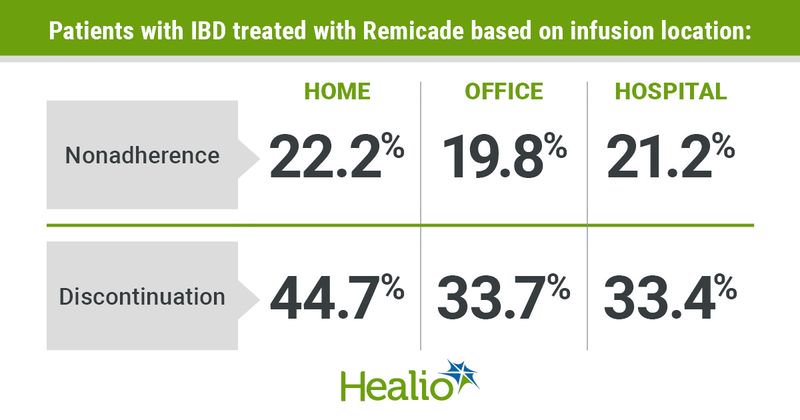Home Remicade infusions linked with suboptimal outcomes in IBD
Patients with inflammatory bowel disease who received home infusions of Remicade had higher rates of nonadherence and discontinuation of the drug, according to study results.
K.T. Park, MD, MS, of Stanford Health Care, and colleagues wrote that home infusions of Remicade (infliximab, Janssen) are becoming more common because of lower costs and payer mandates.

“However, in-home service agencies are often not affiliated with the treating physician’s health system, and there is an absence of regulations regarding infusion practices,” they wrote. “Recent position statements from national societies have highlighted these concerns that home infusions may contribute to fragmentation of care because home biologic infusions require higher level of care coordination and oversight to ensure optimal patient safety, efficacy, and quality.”
Researchers analyzed patient data from the Optum Clinformatics Data Mart to compare biologic medication use, health outcomes and overall cost of care for patients with IBD receiving home versus office- and hospital-based infliximab infusions. Their analysis included all patients with IBD who received infliximab between 2003 and 2016 (n = 27,396; pediatric patients n = 1,839).
The primary outcomes of the study were nonadherence, defined as no more than two infusions over 10 weeks apart in 1 year, and discontinuation of the drug. Investigators also assessed patient corticosteroid use, follow-up visits, emergency department visits, hospitalizations, surgeries and cost outcomes, including both out-of-pocket and annual overall cost of care.
Overall, 5.7% of patients used home infliximab infusions. Patients in this group were more likely to be nonadherent compared with patients who received office-based (22.2% vs. 19.8%; P = .044) or hospital-based infusions (22.2% vs. 21.2%; P < .001). They were also more likely to discontinue infliximab (44.7%) compared with patients in the other two groups (33.7%, P < .001; and 33.4%, P < .001, respectively). Additionally, researchers found that patients who received home infusions had a lower probability of remaining on infliximab by day 200 of therapy than the other groups (64.4% vs. 79.3% vs. 74.2%; P < .001).
Park and colleagues found that home infusions did not decrease the overall annual care costs compared with office infusions ($49,149 vs. $43,466; P < .001).
“This is the first study evaluating health outcomes in pediatric patients with IBD and site of infusion services,” they wrote. “Furthermore, our analysis suggests that home infusions may not be associated with cost savings when considering the total cost of care of the patients with IBD.”

